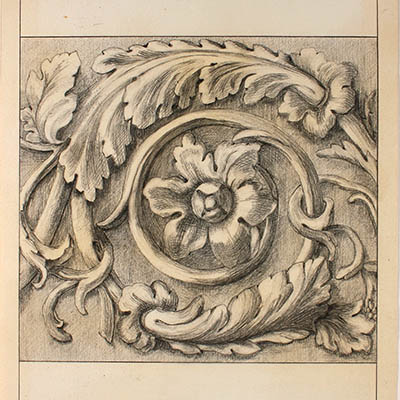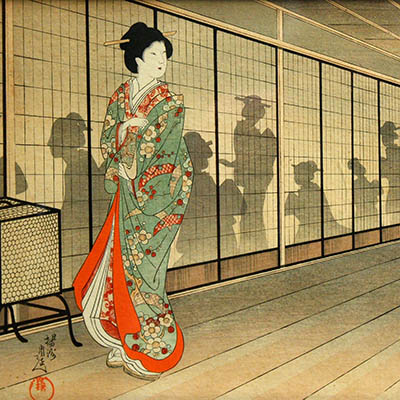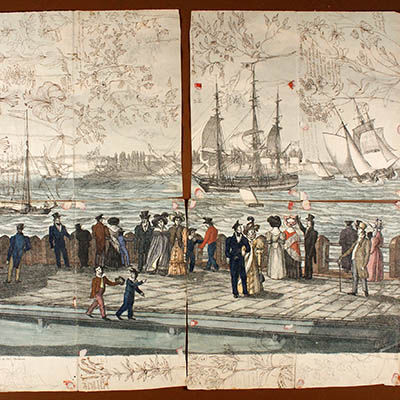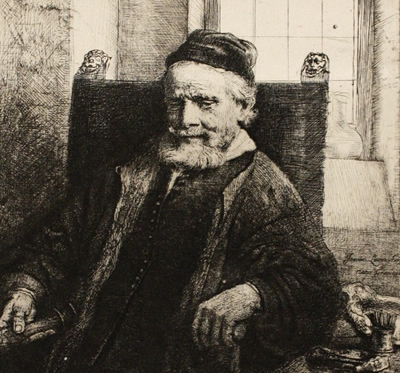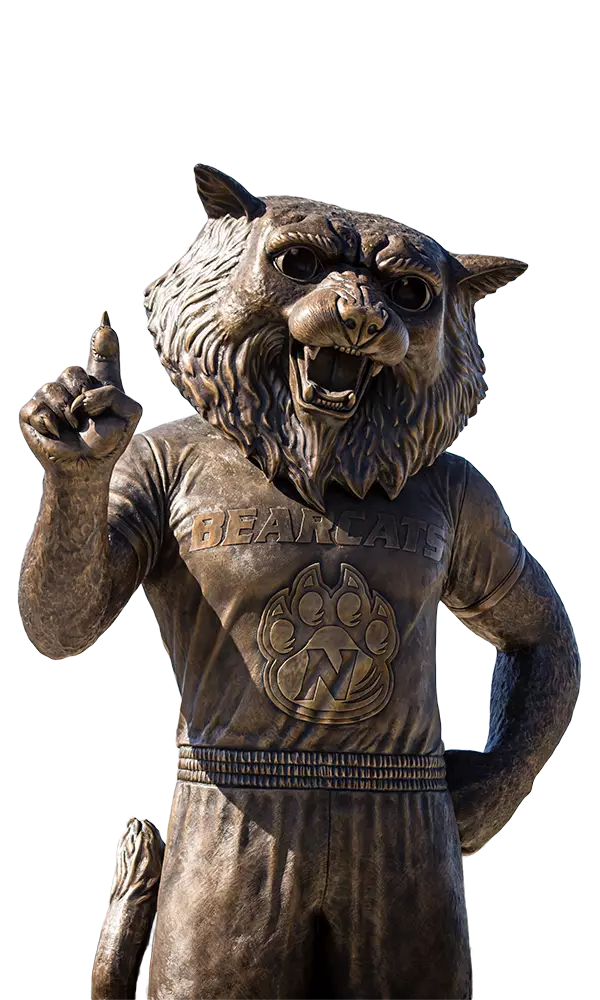Emma Budlong
Emma Akroyd Budlong DeLuce was born in Providence, Rhode Island, on Dec. 24, 1845, the eldest of three children, to James Earl Budlong and Rebecca Salome Coes. James Earl Budlong was the wholesale jewelry business partner of John Rogers Hudson, the stepfather of Percival DeLuce.
Emma graduated at age 19 from the Albany Female Academy on June 14, 1864, where she studied French among other subjects. She did not formally continue further studies until 1898 when, at age 53, she applied to the New York School of Applied Design for Women. This was after her marriage to Percival DeLuce on Aug. 24, 1875, considerable international travel to French-speaking countries in Europe with her husband and giving birth to and raising two children, Marion, who was born in 1879 and died at age 7 of typhoid fever, and Olive, born in 1888.
To understand the kind of artworks in the collection by Emma DeLuce, one must first contextualize them by understanding the aim of her art instruction and the fact that women in the arts did not have the privileges afforded to men. She entered the New York School of Applied Design for Women only six years after socialite, painter and philanthropist Ellen Dunlap Hopkins founded it in New York City. According to New York City author and blogger Tom Miller, “Initially the school was only a step removed from a trade school, its goals were ‘… affording to women instruction, which may enable them to earn a livelihood by the employment of their taste and manual dexterity in the application of ornamental design to manufacture and the arts.’”
This innovative school captured the attention of the arts communities across the United States and internationally, and within two years the enrollment had grown from 45 to 400 students who were each paying a very low annual $50 tuition and creating award-winning works. One can only imagine it was an exciting place and time to be a student. A New York Times article explained “At the school’s opening, Ellen Dunlap Hopkins described her initial 45 students as ‘women who were determined to study in order to compete with men in the arts, and whose endeavor it was to make places for themselves in the branches of their choice, not by asking sympathy and not by taking less pay than men, but by the excellence of their work.’”
By the quality and variety of her works in our collection, the program greatly influenced the type of works she made. As students matriculated, the program rigor seemingly increased, according the following quotation, making students artistically self-reliant: “After passing through the elementary department ‘where the student is taught the first steps,’ according to the (New-York) Tribune on Sept. 30, 1894, she moved to the ‘advanced’ class where ‘she is left to work out her own artistic salvation.’”
Only 20 years after beginning to explore her own artistic “salvation” and after an undetermined amount of time living in Maryville with her daughter Olive, Emma Budlong DeLuce died at the age of 73, on Jan. 21, 1918, at Olive’s Maryville home on Fourth Street. She is buried beside her husband in Greenwood Cemetery in Brooklyn, New York.
Edwin DeLuce
Edwin S. DeLuce was born in New York, the older brother to Percival DeLuce. Other than important life events and dates, detailed information on his life is not available. He is affectionately mentioned, if only briefly, by Olive DeLuce in her memoir, “Percival DeLuce and His Heritage.” In that reference, she mentions he is “called Uncle Ned, a picturesque character who had been Chief Engineer with the United States Fleet under Commodore Perry when China and Japan were opened to western commerce in 1858. He collected bronzes, paintings, and wood and ivory carvings from the countries in which he had traveled, and possessed as well a wealth of anecdote concerning his travels.” In the latter reference, she quotes her father, Percival, as saying, “He told of his brother, Edwin, who homesteaded in Lovelock, Nevada, but returned east, ‘for the wind blew the milk out of the pans.’”
In fact, this brief reference overly simplifies the remarkable career of a U.S. Navy officer who rose with numerous assignments from third assistant engineer in 1849 through second, first and finally chief engineer assigned, according to the Naval Records Collection of the Office of Naval Records and Library, to the steam-frigate, San Jacinto, under the command of Commodore James Armstrong, East India Squadron from 1855 to 1858. The following represent only three years of Edwin’s naval adventures on the San Jacinto, which had been recommissioned and outfitted with the latest experimental engines and drives that frequently caused mechanical problems and delays. The ship, its crew and compliment of diplomats, including Townsend Harris, the recently appointed Consul General to Japan, “negotiated a treaty establishing diplomatic and commercial relations between the United States and Siam. The King of Siam at the time was Mongkut, who was later the subject of the musical … The King and I.” “The ship, at long last, reached Shimoda, Japan, on 21 August (1856) and remained there while Harris was negotiating with Japanese officials concerning the establishment of his consulate, the first official foreign diplomatic office to be permitted on Japanese soil. During his subsequent service as Consul General, Harris persuaded the Japanese government to sign a broad treaty, which opened the country to commerce and brought the nation into the modern world.” “The…San Jacinto weighed anchor and headed for Shanghai. Early in October 1856, mounting hostility toward foreigners in China erupted into the Second Opium War.” As a consequence, the ship was involved in significant military battles assisting the British on the Pearl River, near Canton; accordingly, negotiations with the Chinese determined the United States to be a neutral power in the region.
The ship remained in China for the next year, giving Edwin ample opportunities to collect the items Olive mentions. One such piece in the collection is a bronze Ming Dynasty spittoon, something every sailor would have interest in. His journeys and commissions continued until he retired from the Navy on Dec. 23, 1878. Edwin DeLuce, Uncle Ned, died June 25, 1890.
Thomas Thompson
Thomas Thompson, the grandfather of Percival DeLuce, was born in London, England, on March 25, 1776, and was raised in Kent, England, in the South East portion of the country. This would have been the line of the family, near Canterbury, with whom Percival stayed during his numerous journeys to Europe.
At the Royal Academy of Art, in London, Thompson studied art under Sir Joshua Reynolds, the preeminent English Portrait painter. Thomas was influenced by and would have benefited from acquaintances with many notable contemporary English artists including John Constable, William Hogarth and J.M.W. Turner, among others. He first exhibited at the Royal Academy at the age of 17 and, by the time he was 21, was exhibiting large-scale paintings there and at the British Institute regularly.
From Percival DeLuce and His Heritage, “In the catalogue of the British Royal Academy, Thomas Thompson is listed as a portrait and miniature painter. From the number of marines which he has left, it would appear he was as much or more interested in marine subjects. Of the paintings exhibited at the Royal Academy between 1793 and 1810, there are eight portraits, some of which may be miniatures, and 24 marines.” With the exception of two landscape drawings, one portrait and one map, our collection of works by Thomas Thompson also consists mainly of marine subjects, including harbor scenes, ships at sea and detailed schematics of ships, their scale, type, tonnage, captain’s name, rigging and other information only pertinent to one’s interest in this transportation technology.
His interest in America was realized by a visit in 1818, landing in Baltimore, to explore the country. After a short time, he returned to England to collect his wife and seven children to bring them back to America with him to live as pioneers in the rugged Susquehanna Valley. They faced the extreme tasks of traveling on “roads that were little more than trails, blocked often with boulders and tree trunks, or so muddy carts could hardly get through, or so steep as to make it difficult. The greatest danger, however, was in fording streams, and the fear of lurking Indians was never absent. The attempts of the father and elder sons, none of them accustomed to heavy farm labor, to fell trees for the one-room log house, and to clear the land of rocks so as to make cultivation possible, were valiant but also pitiful. After two years in the Valley, Thomas Thompson was persuaded by his family to move back to Baltimore, later to Philadelphia, and finally to New York, on or before 1829.”
The collection contains two adjoining pieces of New York Harbor from the Battery, which appear to be lithographic “proofs” printed on recycled paper. The work was copyrighted by him in 1829 and is also in the New York, Metropolitan Museum of Art collection. Included in the promenade of fashionable residents on the harbor side (left side) the artist has two of his sons playing in the foreground while his wife and her sister are shown behind them facing forward.
“Thomas Thompson may be included among the small group of American portrait painters of the Federal period who followed the English portrait tradition, were formally trained in art and, after such training migrated to this country or originating here, went to study in England, returning here to practice.
Thompson’s passion for the sea and sailing vessels eclipsed other subjects, including his homesteading experiences. He became a member of the New York National Academy in 1834 and the National Academy of Design in 1835 and exhibited his, “portraits, landscapes, marines, and miscellaneous scenes,” there and at the Academy of Fine Arts in Philadelphia.
He died in Brooklyn, New York in 1852. “The minutes of the of the National Academy of Design inscribed on the books following his death read:
'Nov. 15. The death of Thomas Thompson, an associate of the Institution, was announced. Suitable resolutions were passed, commemorative of the loss the Institution has sustained, and the sympathy felt by the members for the relatives of the deceased, The Academy attended the funeral in a body, and the usual badge of mourning was worn. Mr. Thompson was an aged, nay, a venerable gentleman of the old school, distinguished in his deportment, liberal in his views, and came Promptly forward to aid the Institution by taking it’s bonds.’”
Collected Works
Artwork in the DeLuce Family Collection was gifted to the University as part of the codicil to the will of Olive S. DeLuce, accepted by the Board of Regents, March 9, 1970. These works have numerous sources and include a variety of mediums, including prints (etchings, lithographs, silkscreen, Ukiyo-e), drawings, paintings and basketry.






